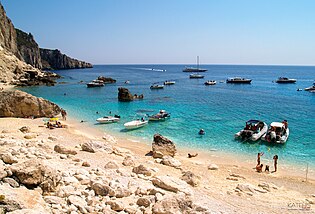Othonoi
A second etymological approach for the latter, is that it derives from the plural of the Greek adjective ostrakinón (οστρακινόν), which is ostrakiná (οστρακινά); likely expressing a quality of the island.
In a letter from April 19, 1383, he granted the usufruct of Othonoi, Ereikoussa, Mathraki, Diapolo and Vido, to the knight Theodore Skaliti as fief.
[5]: 29 In 1537, the Turkish fleet under the command of Hayreddin Barbarossa massacred the inhabitants of Othoni island after a long battle.
In Stavros district at an altitude of 217 m. a white stone cross exists until today to commemorate that event.
This occurred after the Battle of Nafpaktos in 1571 when the Turkish fleet was destroyed and the islanders began to move more safely.
[9] According to legend, the ancient poet Homer referred to Othonoi in the Odyssey as Ogygia, island of the nymph Calypso, who lived in a large cave there.
During the day, he sat on a headland or at the sea-shore crying, while at night he was forced to sleep with Calypso in a cave against his will.
[10] Maps of geographers like Jean-Baptiste Bourguignon d'Anville, Philipp Clüver, Petrus Bertius, and Aaron Arrowsmith, refer to Ogygia as an island northwest of Corfu, Greece.
[5]: 21–22 According to Hesychius, after the Trojan War, Elephenor, king of Avantes, fled from Euboea to the island after the fall of Troy, to atone as he had killed his grandfather, Abas.
[5]: 222 Most Othoniotes (local dialect: Thoniotes) have migrated to Corfu, Athens, and abroad (especially to the USA) because of the unemployment and few exploitable resources (1900–1960).
Other points of interest are the Moshopontikas, Xylosermi, Fyki bay (where there is the sunken wreck of Sarah ship).
Othonoi was frequently visited by the French naturalist Jacques Cousteau and his exploratory vessel Calypso.
The tall mulberry (or Skamnia) and fig (or Skeria) are found in nearly all districts and gardens that host many species of fruit and vegetables, and features large cabbage called by Othoniotes cramps, as in Cyprus.
There are also grouse and snipe (xilokotes) during the winter months, and peregrine falcons, the European bee-eater birds, martins, ravens and several species of eagles.
Also found are almost all varieties of marine fauna, such as the white sea bream, red mullet, the snapper, the grouper, the bumpkin (weighing up to 30 pounds), octopus, moray, the stingray, lobster.
[citation needed] The island is accessible by boat with regular services from Corfu port and Agios Stefanos Avliotes.







